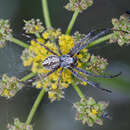en
names in breadcrumbs


The 15 described species in the spider family Diguetidae are known only from the New World (Platnick 2013). Diguetids have six eyes arranged in three pairs (the missing eyes are apparently the anterior median eyes). One of the two recognized genera, Diguetia, includes a single species known from Argentina along with another 10 species known from Mexico and the southwestern United States (according to Bradley [2013], seven of these 10 species are known from the United States). The other genus, Segestrioides, includes four South American species. (Ubick 2005; Platnick 2013)
Like most haplogynes, diguetids have six eyes, but unlike most haplogynes (with the exception of the Pholcidae), Diguetia build extensive snare webs on shrubs or cacti (Ubick 2005). The web is a sheet with surrounding tangle and a vertical tubular retreat, in which females deposit their egg sacs (Boulton and Polis 1999). According to Eberhard (1967), the spiders move along the underside of the sheet and capture prey intercepted by the surrounding tangle web.
Boulton and Polis (1999) undertook a three-year study in the Coachella Valley, California, of reproduction, life history, phenology, microhabitat, prey, and dispersion of Diguetia mojavea, a species that is often abundant in California deserts.
Starrett and Waters (2007) detected evidence of past positive natural selection on HSP70 proteins, a group of highly conserved proteins with important roles in thermotolerance, in the desert-dwelling and heat-tolerant diguetids.
Coneweb spiders (Diguetidae) are six-eyed haplogyne spiders that live in tangled space webs, fashioning a cone-like central retreat where they hide and lay eggs. It is a small family, containing only two genera with fifteen species and is confined to the New World, preferring deserts. Members of the genus Diguetia usually build their webs in shrubs or between cactus pads. They have the same eye arrangement as the venomous recluse spiders (family Sicariidae), but none are known to be harmful to humans.
The group was first created by F. O. Pickard-Cambridge in 1899 as the subfamily Diguetiinae of the family Scytodidae.[1][2] It was raised to the rank of family by Willis J. Gertsch using the spelling "Diguetidae".[3] Pickard-Cambridge's use of double "i" is correct according to Article 29.3 of the International Code of Zoological Nomenclature,[4] since the name is based on the genus Diguetia. In 2004, Jörg Wonderlich suggested reducing it again to a subfamily, this time of Plectreuridae.[5] However, it is still sometimes considered a subfamily of the Plectreuridae.[1]
As of April 2019, the World Spider Catalog accepts the following genera:[1]
Diguetia Simon, 1895
Segestrioides Keyserling, 1883
Coneweb spiders (Diguetidae) are six-eyed haplogyne spiders that live in tangled space webs, fashioning a cone-like central retreat where they hide and lay eggs. It is a small family, containing only two genera with fifteen species and is confined to the New World, preferring deserts. Members of the genus Diguetia usually build their webs in shrubs or between cactus pads. They have the same eye arrangement as the venomous recluse spiders (family Sicariidae), but none are known to be harmful to humans.